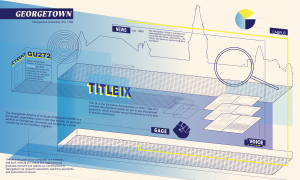Last week, I watched (on Instagram Reels) a record 59,226 runners finish the New York Marathon. I was envious, despite having just finished my first 26.2-mile race at the Marine Corps Marathon. The marathon bug is real and spreading.
In high school, I played tons of sports until settling on track and field (I’m proud to hold my high school’s 4×800 record, but we don’t have to talk about my flop performance in the state 3200). Upon arriving at college, I missed a space dedicated to pushing myself, so I hopped on the marathon train.
While running 26.2 miles is a uniquely intimidating achievement, I believe most anyone can do it with the right training, planning, and mindset.
I’m no running expert, but for any college folks who need a change of pace from the daily academic grind to something a little more sweaty, I’ve accumulated my personal tricks to help you on your marathon journey.
Getting a bib early:
Starting early is key for marathons. Beyond the long training stint—most plans range from 16 to 20 weeks—marathons are a hot commodity! Bibs sell out fast, often more than a season ahead of race day, and the prices can climb up to hundreds of dollars. Buy early, ideally right at the start of your training block.
I did not do this, and the Marine Corps was sold out by the time I realized I actually needed a race to run. The secret hack is to run with a charity. I raised $800 for Girls on the Run with a scary amount of ease and only had to pay $100 for the actual race (a steal compared to the $500 starting price).
Fitting a marathon into your GCal:
It would be trite for me to emphasize how little time Georgetown students have (or feel that they have), but trust me, a marathon is well worth it and may actually teach you work-life balance. The easiest (although perhaps most painful) way to fit runs into your schedule is to become an early riser. I did all my long runs at 6 a.m., and it was quite a relief to go on with my day without the looming four-hour run. Still, I understand that running on five hours of sleep isn’t for everyone. My advice would be to set aside one morning on the weekends—I often did Sunday morning because I tended to be less incapacitated from the night before—when you can wake up at a comfortable time and get it done.
You don’t have to run all the time:
Most plans entail running nearly every day as your primary form of training. If you’re interested in this, Runner’s World has some great free ones. But, while some runners may shame me for this, I don’t think you have to follow that. As I see it, the weekly essentials are the long run, the high-intensity workout to build speed and endurance, and maybe one other easy run to keep your body used to the motion. Beyond that, keeping up cardio work is a good idea, but there are many ways you can do that: biking, swimming, zumba, if that’s your thing. Additionally, strength training often goes neglected by runners—my physical therapist once told me I had weak glutes—so if you feel the need to trade in your run for a CorePower session, go for it! Your glutes will thank you on mile 17.
Gels and your stomach:
When I reached mile 15 of my long run, I couldn’t help but wonder, “Why am I so tired? And hungry?” I needed fuel. Yes, a perk of marathoning is that eating pasta becomes productive, but you also need to fuel during your runs, which means getting used to the strange world of gel consumption. GU gels are popular, and to that I say, “No, thank you.” I can’t get down with the aftertaste. My preference is the Honeystinger and GO gels, both of which taste like fun baby food. They don’t go to war with my stomach personally, although be warned: that may be different for yours. Make sure to test any new gels on training runs multiple times before race day, especially caffeinated ones. If you’ve ever had a coffee then had to sprint to the bathroom before class, you’ll understand.
To vest or not to vest:
Because running is TikTok famous, the running industry has latched onto this moment to assure you that you need every possible product to maximize your runs—and the vest is their poster child. I have qualms with the vest, simply because I get hot easily and end every run stripped down to my sports bra. If you can regulate your body temperature, be my guest, but if you’d rather stay cool, try a running belt and a handheld water bottle.
The big day and the playlist to carry you through it:
I don’t have much of a pre-race ritual. I pick my race-day fit morning-of based on vibes (which is probably how I ended up with massive inner-thigh chafing) and fuel with handfuls of granola. However, even if my breakfast is scavenged, my playlist is always curated. My best advice is to pick music that you’re genuinely excited to listen to, which doesn’t necessarily need to be traditional hype songs. “Dancing Through Life” (the movie version, sorry!) really did something for me at mile 22.
If anything you read piqued your interest, just download a free plan and try out the first week of training. Trust me—it’s easy to get hooked.





